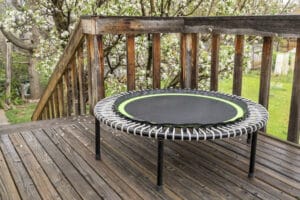Is it a good idea to put a trampoline in the ground?
Key Takeaways
- Safety: In-ground trampolines have increased safety due to their lower height, making the risk of falling significantly reduced. They are also easier to access without the need for a ladder or steps.
- Aesthetics: In-ground trampolines blend seamlessly with the surrounding landscape, creating a visually appealing environment. They have a low-profile design that does not block any views within the yard.
- Stability and Resistance to Wind: In-ground trampolines have enhanced stability and are less likely to tip over, especially during strong winds. The secure installation provides a more reliable and stable jumping experience.
Trampolines are a popular source of outdoor entertainment and exercise for both children and adults. When it comes to choosing a trampoline, one decision to consider is whether to install it above ground or in the ground. In-ground trampolines have gained popularity in recent years, but is it a good idea to put a trampoline in the ground? Let’s explore the benefits and safety considerations to help you make an informed decision.
The Benefits of In-Ground Trampolines
There are several advantages to installing a trampoline in the ground:
- Safety: One of the primary benefits of in-ground trampolines is increased safety. With their lower height, the risk of falling from a higher position is significantly reduced. In-ground trampolines are closer to the ground, making it easier for children and people with mobility issues to access without the need for a ladder or steps.
- Aesthetics: In-ground trampolines blend seamlessly with the surrounding landscape, creating a more visually appealing environment. Their low-profile design does not block any views within the yard, enhancing the overall aesthetics of the outdoor space.
- Stability and Resistance to Wind: In-ground trampolines have enhanced stability due to being embedded in the ground. This reduces the risk of tipping over, especially during strong winds. The secure installation provides a more reliable and stable jumping experience.
- Potential for Better Bounce: Proper ventilation around an in-ground trampoline can improve airflow, resulting in better bounce. With the trampoline level with the ground, air can flow freely underneath, allowing for higher jumps and potentially increasing safety during use.
- Longevity: In-ground trampolines generally have a longer lifespan compared to above-ground trampolines, lasting anywhere from 5 to 10 years. Their durable construction and resistance to weather and wear and tear contribute to their extended lifespan.
Safety Considerations for In-Ground Trampolines
While in-ground trampolines offer various safety benefits, it is essential to be aware of potential safety concerns:
- Pinching Injuries: In-ground trampolines still pose the risk of pinching injuries from the springs or frame. Users should exercise caution and follow safety guidelines to minimize the risk of accidents.
- Surrounding Area: It is important to ensure the area around the in-ground trampoline is free from hazards. Clear any sharp objects or debris that could cause injuries during use. Additionally, the trampoline should be located in a safe area, away from power lines, trees, buildings, and fences.
- Proper Installation and Maintenance: In-ground trampolines require effort for installation, including excavation and other installation expenses. It is crucial to follow the manufacturer’s instructions carefully and ensure proper installation to maximize safety. Regular maintenance, such as checking for wear and tear, is also essential to keep the trampoline in good condition.
Expert Opinions and Statistics
Expert opinions and statistical data on the safety of in-ground trampolines are not provided in the available information. However, the benefits and safety considerations mentioned above are commonly acknowledged in the trampoline industry.
Conclusion
Deciding whether to put a trampoline in the ground depends on various factors, including personal preferences, safety concerns, and budget. In-ground trampolines offer increased safety, enhanced aesthetics, stability, potential for better bounce, and a longer lifespan. However, it is essential to consider the safety considerations and proper installation and maintenance practices to ensure a safe and enjoyable experience.
Related Websites:
- Captain Patio – In-Ground Trampolines vs Above-Ground Trampolines
- Vuly Play – In-Ground vs Above-Ground Trampolines
- Trampolines.com – In-Ground vs Above-Ground Trampolines
- Springfree Trampoline – Are In-Ground Trampolines Safer?
- Machrus – Are In-Ground Trampolines Safer?
- All Things Backyard – Best In-Ground Trampoline
FAQs:
Q: What are the benefits of installing an in-ground trampoline?
Installing an in-ground trampoline offers several benefits. Firstly, it reduces the risk of falls and injuries as the trampoline sits closer to the ground. Additionally, it blends with the surroundings, providing an aesthetically pleasing look that preserves the overall landscape. Furthermore, an in-ground trampoline offers easier access for children and individuals with limited mobility, promoting inclusivity.
Q: What should I consider before installing an in-ground trampoline?
Before installing an in-ground trampoline, it is important to consider yard space and usability. Evaluate the available space and ensure it can accommodate the trampoline while still allowing for other outdoor activities. Proper drainage and leveling are also crucial to prevent water accumulation and ensure optimal safety and performance. Lastly, professional installation or careful DIY installation is necessary for stability and regular maintenance is required to keep the trampoline in good condition.
Q: What are the potential challenges of installing an in-ground trampoline?
While in-ground trampolines offer many benefits, there are some potential challenges to consider. Firstly, the cost and effort of installation may be higher compared to above-ground options, as it may involve excavation and landscaping adjustments. There is also the potential for water accumulation and damage if proper drainage solutions are not in place. Additionally, in-ground trampolines have limited portability and flexibility, making it difficult to relocate them in the future.
Q: Are in-ground trampolines safer than above-ground trampolines?
Yes, in-ground trampolines offer increased safety compared to above-ground options. Placing the trampoline in the ground reduces the height from the ground, minimizing the risk of falls. Additionally, safety measures such as padding and safety nets can be used for added protection. However, it is important to follow proper installation and maintenance guidelines to ensure ongoing safety.
Q: Can an in-ground trampoline be relocated in the future?
In-ground trampolines have limited portability and flexibility, making it challenging to relocate them in the future. Unlike above-ground trampolines that can be easily moved, in-ground trampolines are designed to be more permanent fixtures in the outdoor space. Therefore, it is important to carefully consider the desired location before installation.






